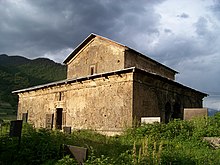Ienashi church
იენაშის იონა წინასწარმეტყველის ეკლესია | |
 Ienashi church of the Prophet Jonah | |
 | |
| 43°00′45″N42°37′48″E/ 43.012363°N 42.630115°E | |
| Location | Ienashi,Mestia Municipality,Samegrelo-Zemo Svaneti,Georgia |
|---|---|
| Type | Hall church |
TheIenashi church of the Prophet Jonah(Georgian:იენაშის იონა წინასწარმეტყველის ეკლესია,romanized:ienashis iona ts'inasts'armet'q'velis ek'lesia), also known as the church ofIan(Svan:ჲან), is a medievalGeorgian Orthodoxchurch inMestia,Upper Svaneti.The church was built sometime between the 12th and 14th centuries, but reflects an earlier Georgian practice by having a semi-openaisle—anambulatory—terminating in anapseto the east of the mainnaveof the building. The church is inscribed on the list of theImmovable Cultural Monuments of National Significanceof Georgia.[1]
Location
[edit]The church of theProphet Jonahis situated in the village of Ienashi, at 1360 m above sea level, in the Latali territorial unit of the Mestia Municipality, at the foothills of theGreater Caucasus.This part of Svaneti was known asFree Svanetiin the 19th century. There are no contemporary literary sources on the construction and history of Ienashi. The church and the items preserved in it were first described, in greatest details, by the scholarEkvtime Taqaishviliduring his expedition to Svaneti in 1910.[2]
Layout
[edit]
The Ienashi church is built of evenly cutlimestoneblocks. It is a hall church, with an ambulatory running on three sides and terminating in an apse on the east. The interior is divided up intobaysby a pair of two-step pilasters which support a vaulted arch. The church is lit by windows cut in the sanctuary apse and central west wall; a window in the south wall is blocked by an outer annex attached to the wall. Arched niches flank the window in the apse. There are two doors, on the south and west. The church has two annexes, both arched in the interior and covered with architraves on the exterior. The façades are scarcely decorated in stonework. The building is based on a two-stepsocleand crowned by a pronouncedcornice.[3]
The interior is adorned with a series of frescoes, but they are heavily damaged. The style of the paintings is a local take on the late ByzantinePalaeologan art.Depicted are theSavior,the cross of Golgotha,David,Solomon,Jonah and the whale,the saintsPeterandPaul,theChurch Fathers,and an unidentified royal person, probablyConstantine I of Imereti(r. 1293–1327).[4]
The church formerly housed many unique items; some of them were lost in a series of burglaries, others were recovered and removed for safekeeping to the Svaneti Museum of History and Ethnography inMestia.Among these items were the Ienashi Gospel book—a 13th-century illuminated Georgian manuscript[5]—as well the icons with gilded and silver elements, such those of the Savior and the saintsGeorgeandTheodore,and precious metal crosses,[2]one being an Italian import of the 13th–14th century.[6][7]
References
[edit]- ^"List of Immovable Cultural Monuments"(PDF)(in Georgian). National Agency for Cultural Heritage Preservation of Georgia.Retrieved3 July2019.
- ^abTaqaishvili, Ekvtime (1937).არქეოლოგიური ექსპედიცია ლეჩხუმ-სვანეთში[Archaeological expedition to Lechkhumi and Svaneti](PDF)(in Georgian). Paris. pp. 338–349.
{{cite book}}:CS1 maint: location missing publisher (link) - ^"სოფ. იენაშის იონა წინასწარმეტყველის ეკლესია"[Church of John the Prophet in the village of Ienashi].კულტურული მემკვიდრეობის გის პორტალი [GIS portal of cultural heritage](in Georgian). Archived fromthe originalon 25 August 2019.Retrieved25 August2019.
- ^Kenia, Marine (2002). "სამეფო პორტრეტი იენაშის იანის ეკლესიის მოხატულობაში" [A royal portrait in murals of the Iani Church of Ienashi].Sakartvelos Sidzveleni(in Georgian).2:94–106.
- ^Taqaishvili, Ekvtime (1937). "Antiquities of Georgia".Georgica.4–5:97–100.
- ^Machabeli, Kitty (1960). "XIII-XIV საუკუნეების იტალიური ხელოვნების ძეგლი ზემო სვანეთში" [A monument of the 13th–14th-century Italian art in Upper Svaneti].Sakartvelos SSR Mets'nierebata Akademiis Mats'ne(in Georgian).1:241–250.
- ^Matchabelli, Kitty (1967). "La Svanetie, gardienne de trésors".Bedi Kartlisa.23–24: 52–53, 80–82.
]
